Art is a diverse range of human activities and the products of those activities, usually involving imaginative or technical skill.
Calligraphy

Painting

Rugs and carpets

Ceramics

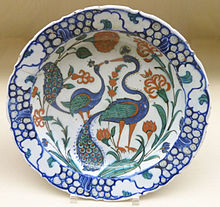
Tiling
 Tiled exterior of the Friday Mosque of Herat, Afghanistan
Tiled exterior of the Friday Mosque of Herat, Afghanistan
Glass
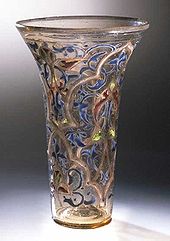 "The Luck of Edenhall", a 13th-century Syrian beaker, in England since the Middle Ages.
"The Luck of Edenhall", a 13th-century Syrian beaker, in England since the Middle Ages.
Metalwork
 Ganja khanate gold jewelery (Azerbaijan State Museum of History)
Ganja khanate gold jewelery (Azerbaijan State Museum of History)
Other applied arts
 Mughal dagger with hilt injade, gold, rubies and emeralds. Blade of damascened steel inlaid with gold.
Mughal dagger with hilt injade, gold, rubies and emeralds. Blade of damascened steel inlaid with gold.
Precious stones
House and furniture
 Ottoman marquetry and tile-top table, about 1560
Ottoman marquetry and tile-top table, about 1560
Ivory
 Ivory with traces of paint, 11th–12th century, Egypt
Ivory with traces of paint, 11th–12th century, Egypt
Silk
 Ilkhanid piece in silk, cotton and gold, Iran or Iraq, early 14th century
Ilkhanid piece in silk, cotton and gold, Iran or Iraq, early 14th century
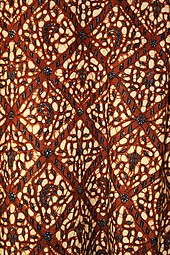 Javanese court batik
Javanese court batik
History of Islamic art
Beginnings
Pre-dynastic
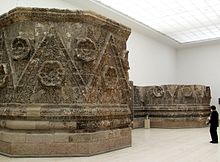 Palace facade from Mshatta in Jordan, now in the Pergamon Museum, Berlin, c. ?740
Palace facade from Mshatta in Jordan, now in the Pergamon Museum, Berlin, c. ?740
Umayyad
 Mosaics from the riwaq (portico) of the Great Mosque of Damascus.
Mosaics from the riwaq (portico) of the Great Mosque of Damascus.
Abbasid
 Luster-ware bowl from Susa, 9th century, today in the Louvre.
Luster-ware bowl from Susa, 9th century, today in the Louvre.
Medieval period (9th–15th centuries)
Spain and the Maghreb

Arab Mashriq
Iran and Central Asia
 Bibi-Khanym Mosque, Samarkand,Uzbekistan, built by Timur in 1399.
Bibi-Khanym Mosque, Samarkand,Uzbekistan, built by Timur in 1399.
Ilkhanids
The Golden Horde and the Timurids
Syria, Iraq, Anatolia
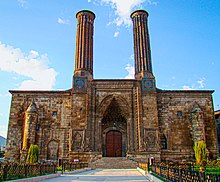
South Asia
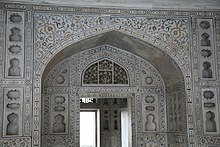 Arabesque inlays at the MughalAgra Fort
Arabesque inlays at the MughalAgra Fort
The Three Empires
Ottomans
 16th century İznik pottery.
16th century İznik pottery.
Mughals
 An illustrated manuscript of theMughal Emperor Shah Jahan attending the marriage procession of his eldest son Dara Shikoh. Mughal-Era fireworkswere utilized to brighten the night throughout the wedding ceremony.
An illustrated manuscript of theMughal Emperor Shah Jahan attending the marriage procession of his eldest son Dara Shikoh. Mughal-Era fireworkswere utilized to brighten the night throughout the wedding ceremony.
Safavids and Qajars
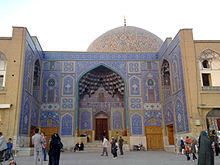 Entrance to Sheykh Lotfollah mosque, Naqsh-e Jahan Square,Isfahan
Entrance to Sheykh Lotfollah mosque, Naqsh-e Jahan Square,Isfahan
Modern period
 Bou Inania Madrasa,Fes, Morocco, zelligemosaic tiles
Bou Inania Madrasa,Fes, Morocco, zelligemosaic tiles


